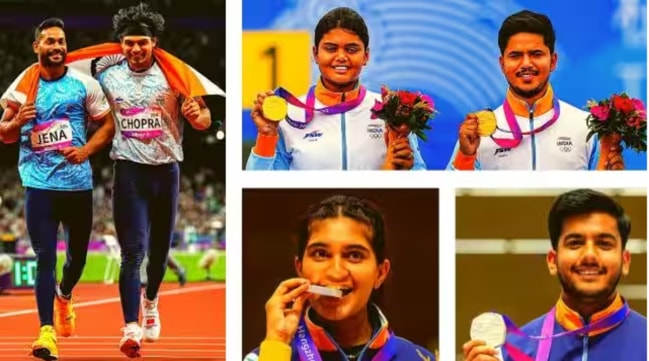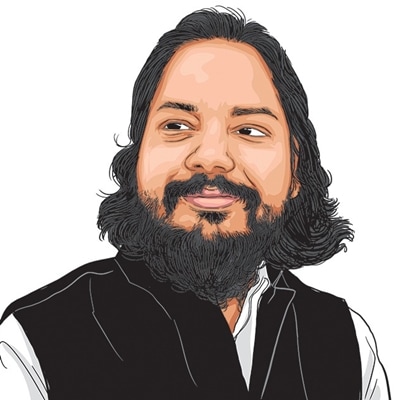Opinion The secret to India’s Asian Games success? An empowering sports policy
Along with progress in poverty alleviation and other socio-economic factors, meticulous planning and greater budgetary allocations have helped Indian athletes rack up impressive wins across different sporting events
 Once challenged to provide for all basic needs, India now boasts the surplus resources required to invest in sports development and cast a wide net to harness a potential talent pool. However, more concerted efforts are needed to make sports a mass movement. (Photo: PTI)
Once challenged to provide for all basic needs, India now boasts the surplus resources required to invest in sports development and cast a wide net to harness a potential talent pool. However, more concerted efforts are needed to make sports a mass movement. (Photo: PTI) The recently concluded 19th Asian Games ignited euphoria across India, with the Indian contingent achieving its best-ever medal tally. India’s fresh surge in sporting success isn’t a mere fluke, but rather the product of a meticulously planned sports development policy. Achieving excellence in sports necessitates not only substantial socio-economic progress but also a large talent pool that has access to high-quality sports infrastructure and resources. India, boosted by significant socio-economic growth and well-designed policy initiatives, has successfully cultivated both of these crucial elements. However, while we celebrate this success, it’s essential to remember that there is still much more to be achieved for India to emerge as a true sporting giant in multi-sport events.
Instead of the total population size, it is the “effectively participating population” (Anirudh Krishna and Eric Haglund, 2008) that matters in whether podium finishes will happen or not. This explains how low-population countries like Japan and Australia have consistently performed well in multi-sport events. Essentially, a population can only actively participate in sports when their basic needs like healthcare, education, nutrition, etc., are adequately met. However, even a population with the luxury to dabble in sports can face significant barriers if the necessary infrastructure is inaccessible. Thus, this requires the adequate long-term mobilisation of public expenditure and resources to make sports participation accessible.
Ensuring accessible sports participation and grooming Olympic-level sports talent are challenging endeavours for the state. The state must bear not only the one-time costs of establishing dedicated infrastructure but also the recurring expenses associated with maintaining the necessary governance and implementation machinery. This presents a substantial hurdle for countries with limited resources. For instance, research suggests that developing countries like Argentina and Brazil, which excel in team sports, lag in individual athletic and swimming events — categories that contribute significantly to medal counts in events like the Olympics — due to their inability to mobilise the requisite resources.
On the other hand, India has shown strong performances across different sports lately. This was established at the 2022 Commonwealth Games, where India secured the fourth rank, despite the absence of certain sports with high medal potential. In fact, India also performed well at the 2021 Summer Deaflympics, securing its best-ever performance in the multi-sport event. Similarly, India has done exceedingly well in important tournaments of other sports such as women’s hockey, javelin throw, relay race, squash, and badminton.
So, what has worked? India has shown favourable socio-economic progress. Whether it is the significant reduction in extreme poverty, rise in literacy and enrollment rates, better access to services like water, sanitation and electricity, offering stable political leadership, or having an economic progress rate that is globally enviable, India has come a long way in providing for citizens. While India’s overall development progress is now being increasingly recognised globally, its sustained sports policy planning effort must be understood.
One of the most tangible indicators of this meticulous planning can be seen in the budgetary allocation for the Union Ministry of Youth Affairs and Sports, which has nearly doubled from 2014-15 to 2023-24, reaching approximately Rs 3,400 crores. Over two-thirds of this budget allocation is designated for the Department of Sports. This allocation reflects the government’s commitment to establishing a world-class talent identification infrastructure. A noteworthy initiative in this regard is the Khelo India Scheme, which has received substantial financial backing. The scheme has played a pivotal role in providing opportunities to approximately 23 lakh school children, identifying potential talent that can be nurtured and developed further. It acknowledges the fact that talent is often evenly distributed, but opportunities are not. The current sports policy approach is empowering and democratising the opportunity for young individuals to engage in sports. For instance, the establishment of over 1,000 Khelo India Centers in districts aims to bolster grassroots-level sports infrastructure. Simultaneously, it offers a source of income for local sporting talent by involving them as sports coaches.
Further, there are concerted efforts to instill a culture of sports and fitness from an early age, exemplified by efforts like the FIT India Movement and the incorporation of sports within the landmark National Education Policy 2020. There is dedicated support for exceptionally gifted talent through the Target Olympic Podium Scheme (TOPS). This programme provides elite athletes with comprehensive assistance, including funding, specialised equipment, international exposure, top-tier coaching, and a monthly allowance of Rs 50,000 for Core Group athletes and Rs 25,000 for Developmental Group athletes. Over the years, TOPS has made a substantial contribution to India’s success in various multi-sport events, including the Commonwealth Games, the Asian Games, the Asian Para Games, and the Youth Olympics. Champion athletes like P V Sindhu and Sakshi Malik have been beneficiaries of this programme.
However, the effectiveness of these policies must not lead us to overlook the gaps that still require attention. Inherent governance challenges, including corruption and a lack of ethical conduct, remain significant hurdles. Sports governing bodies, such as those for table tennis, cricket, football, and boxing, have faced numerous issues. Furthermore, the availability of proper sports infrastructure, particularly in educational institutions and in underdeveloped states like Bihar, Jharkhand, and Odisha, remains severely limited. While there has been an increase in sports infrastructure, often matching international standards, it’s primarily concentrated in a handful of states like Haryana, Punjab, and Karnataka. Moreover, the issue of underutilisation of resources and infrastructure persists. For instance, the Standing Committee on Human Resource Development noted in 2019 that, despite substantial allocations of Rs 520 crore and Rs 500 crore to the Khelo India scheme in 2018-19 and 2019-20, respectively, the actual expenditure was only Rs 324 crore and Rs 318 crore, respectively. Other challenges include a shortage of coaching staff, gender disparities, and difficulties in attracting support from the private sector. Evidently, there is still much work to be done.
India’s rise in sports is growing concurrently with the rise in its soft power. From hosting the 2017 FIFA U-17 World Cup, 2023 Men’s FIH Hockey World Cup to the 2023 ODI Cricket World Cup, India is exerting its influence holistically. Domestically, stellar sports performance has vital consequences. A country that is able to win more medals in sports is also able to foster talent in other areas, enabling social mobility. This is visible in India’s case. The ability to offer enhanced focus to sports, especially those that are not often considered “mainstream”, is an assertion of India’s swift pace for the fulfilment of the development goals. Once challenged to provide for all basic needs, India now boasts the surplus resources required to invest in sports development and cast a wide net to harness a potential talent pool. However, more concerted efforts are needed to make sports a mass movement. As we look towards the Paris 2024 Olympics, despite the different categories of sports, it would come as no surprise if India continues to shine brightly on the global sporting stage.
The writer is director of Center of Policy Research and Governance





